Reviving Dull Granite Countertops: Practical Techniques


Intro
Granite countertops are often the crown jewels of a kitchen or bathroom, prized for their strength and natural beauty. However, even the most stunning surfaces can lose their shine due to neglect, spills, and the build-up of grime over time. It's quite the path from pristine to dull, yet homeowners need not despair. Restoring this beautiful stone to its former glory doesn't necessarily require a professional; with the right techniques and understanding, anyone can tackle the task.
This guide will elucidate effective cleaning methods, polishing techniques, and maintenance strategies tailored for granite. Whether you're a homeowner looking to spruce up your space or an enthusiast keen on extending the life of your surfaces, we've got the know-how to enhance your countertops. Let's embark on this journey to revive not just a surface, but the heart of any gathering place.
Understanding Granite Countertops
Granite countertops are more than just a trendy addition to kitchens and bathrooms; they are the backbone of durability and elegance in home design. Given their toughness against scratches and heat, granite offers an array of benefits, like enhancing property value and lending a timeless aesthetic that never goes out of style. However, understanding granite is key to maintaining its allure. With a proper grasp on what granite is, how it behaves, and what issues might crop up, homeowners can take better strides towards preservation and revitalization.
Granite's Composition and Characteristics
Granite is an igneous rock, formed from magma that cools slowly beneath the Earth's surface. This cooling process gives granite its characteristic speckled appearance. Composed primarily of quartz, feldspar, and mica, this sturdy stone boasts not just beauty but remarkable resilience. Each slab is unique, with various mineral colors and patterns, which means there’s a piece of granite for every taste.
Its dense composition lends granite strength, making it ideal for heavy-duty kitchen counters. Additionally, the non-porous nature of polished granite means it's resistant to moisture, which helps in avoiding stains and bacterial growth. The aesthetic appeal combined with practical characteristics like heat resistance and easy wipe-clean maintenance makes granite a coveted choice.
However, many homeowners may underestimate the importance of understanding these aspects. A common misconception is that granite can withstand any kind of wear. While it is tough, neglect and misuse—like cutting directly on it or using harsh chemicals—can lead to dullness over time, detracting from its once-vibrant look.
Common Issues with Dullness
Over time, even the most stunning granite countertops can turn drab. Several factors contribute to this dullness, often stemming from environmental conditions or human actions. One of the primary culprits is neglecting regular cleaning. Grease, food residues, and spills can build up, dulling the surface and creating an unwelcoming appearance.
Another issue comes from the harsh cleaners which some homeowners might think are beneficial. These can wear down the protective sealant applied on granite, leading to scratches and dull spots. Apart from environmental factors, stains from oil, wine, or acidic substances can seep into areas that are improperly sealed, causing permanent discoloration.
To sum up, understanding both the composition of granite and the common issues associated with it is vital. Not only does it empower homeowners with knowledge, but it also lays the foundation for effective restoration practices that are covered later in this guide. Becoming a steward of your granite is crucial to extending its lifespan and keeping your surfaces radiant.
"Knowledge is the key to maintaining the beauty and integrity of your granite countertops."
Assessment of Dullness
Assessing dullness in your granite countertops is a crucial step that often gets overlooked. Before you dive into restoration techniques, it’s essential to understand the specific nature of the dullness and any underlying damage. Knowing precisely what you’re facing makes it easier to choose the appropriate cleaning products and polishing methods. Moreover, the assessment serves as a baseline, helping you track improvements as you implement care practices.
Evaluating the Surface
Evaluating the surface of your granite countertop involves checking for various signs that indicate dullness or wear. Here’s what to look for:
- Sheen Loss: This is typically the first sign. If your countertop used to shine and now looks lackluster, it’s time to assess.
- Color Fading: If your countertops appear washed out or lighter than their original hue, this can be a sign of wear.
- Texture Changes: Run your fingers across the surface. If it feels rough, as opposed to smooth, your granite may need professional help or thorough polishing.
Using good lighting helps in your evaluation. Natural light works best, as it can highlight any imperfections missed under artificial light. Moreover, consider the angle at which you look at the counter. Sometimes, flaws can only be seen from certain angles, so being diligent pays off.
Identifying Stains and Damage
Next comes the task of identifying stains and structural damage. A thorough inspection of the surface will help illuminate serious issues that need addressing:
- Common Stains: Look out for grease marks, water spots, or food residues. These are usually easy to spot but can sometimes pervade the surface.
- Deep Scratches: Use your fingernail to feel for indentations or scratches. If your nail catches, you’re likely dealing with a deeper issue that may require repair.
- Cracks and Chips: Examine corners and edges, as these areas are frequently more susceptible to chipping. If you see any cracks, take note of how deep they are; if they run through the entire stone, immediate action may be necessary.
If stains or damage are present, remedial action is crucial. Remember, trying to polish over damaged areas can often lead to more significant issues down the line, such as further dullness or exacerbated cracks. Instead, focus on a targeted approach—clean the area first, then assess if a polishing treatment or repair is in order.
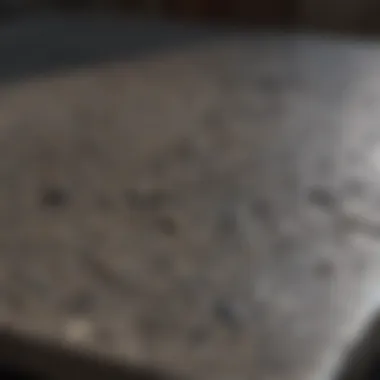

"A well-cared-for granite countertop is not just a surface but an integral part of your home’s aesthetic and functionality."
Cleaning Techniques for Granite
When it comes to keeping the elegance of granite countertops, the cleaning techniques adopted play a pivotal role. Granite is not only a sturdy material but also a venue for culinary creativity and social gatherings. Yet, it demands respect and proper care to maintain its beauty. As the surface bears the brunt of daily activities, it can gradually lose its shine. Thus, understanding the right cleaning methods is essential for homeowners who want their countertops to reflect the same brilliance as the day they were installed.
Choosing the Right Cleaners
Selecting the right cleaners is crucial for granite maintenance. Not all cleaning products cater to the delicate nature of granite surfaces. Avoiding harsh chemicals can save your countertops from long-term damage. Look for pH-balanced cleaners specifically formulated for stone. Often, these are made with natural ingredients that won't erode the finish of granite.
- Consider ingredient lists: Look at what’s in the cleaner. Avoid bleach, vinegar, or lemon juice as they can dull the surface over time.
- Pick branded options: Some trusted brands like Granite Gold or Weiman offer effective solutions.
- Spot test: Before applying any new cleaner widely, always conduct a small test on an inconspicuous area.
Choosing the appropriate cleaner sets a solid foundation for your cleaning process — one that ensures your granite remains radiant and durable.
Step-by-Step Cleaning Process
Implementing a proper cleaning routine for granite is like fine-tuning a recipe—each step matters. Here’s how to get your countertops back into shape:
- Clear the Surface: Start by removing all items from the countertop. This allows you to access every inch without obstacles.
- Dust and Debris: Using a microfiber cloth or soft broom, sweep up any dust or crumbs. Microfiber picks up dirt effectively without scratching the surface.
- Apply Cleaner: Spray the chosen granite cleaner generously over the surface. Always follow the product's instructions for best outcomes.
- Wipe with Cloth: Use a soft cloth to wipe the surface in circular motions. This method avoids streaks and allows for an even application of the cleaner.
- Rinse: After wiping, rinse the cloth thoroughly and go over the surface again with clean water to remove any leftover cleaner.
- Dry Thoroughly: Finish up by drying the countertop with a clean, dry microfiber cloth to prevent water spots.
This succinct process not only removes grime but also keeps your granite intact and appealing.
Preventing Future Buildup
Preventative measures can save you hours of scrubbing down the road. Implement these simple practices to keep your granite looking its best:
- Wipe Spills Immediately: Granite is porous, and quick action can prevent stains. Make it a habit to clean up messes as soon as they happen.
- Use Coasters and Mats: When placing fabric or containers on countertops, utilize coasters or padded mats to avoid scratches and heat damage.
- Avoid Harsh Cleaners: Sticking to gentle, pH-neutral soaps will go a long way in preserving the finish.
"An ounce of prevention is worth a pound of cure" – this couldn't ring truer for granite countertops.
By adopting these habits, homeowners can maintain the allure and extend the life of their granite surfaces while making cleaning a more manageable task.
Polishing Dull Granite Countertops
Granite countertops are a staple in many homes due to their elegance and durability. However, over time, even the most beautiful granite can lose its shine and look tired. Polishing may seem like a cosmetic luxury, but it plays a crucial role in maintaining not only the appearance but also the integrity of the surface. It can help restore that reflective quality that elevates your kitchen or bathroom aesthetics. In this section, we will explore different types of polishing products, effective techniques, and the use of advanced equipment like buffing machines to bring back that newly-installed sheen.
Types of Polishing Products
When it comes to polishing granite, choosing the right product is essential. Various options are available, and each serves a different purpose based on the specific needs of your granite surface:
- Polishing Powder: Typically made from fine abrasives, this powder works well for removing light scratches and restoring shine. It’s easy to use—just mix it with water to create a paste.
- Liquid Polish: This is a more user-friendly solution, which is beneficial for those who may shy away from powders. Liquid polishes are ideal for quick touch-ups and maintaining shine on a regular basis.
- Granite-Safe Cream: A thicker alternative that ensures the polishing process is gentle on your countertop while still providing excellent results.
- Diamond Polishing Pads: Used for deeper restoration, these pads require a special tool, but they can achieve remarkable results, especially on heavily worn surfaces.
"Choosing the right product involves understanding your granite's condition, so read the labels thoroughly."
Techniques for Effective Polishing
Polishing granite countertops isn’t just about slapping on a product and calling it a day. It requires attention to detail and a few tried-and-true techniques to attain that showroom finish:
- Preparation: Clear the countertop of all items and thoroughly clean the surface to remove dirt and debris. This step will prevent any scratches during the polishing process.
- Application: Apply your chosen polishing product. If you’re using powder, make sure it’s appropriately mixed to the right consistency. For liquids or creams, a microfiber cloth helps to spread evenly.
- Buffing: Use a soft cloth or a buffer. If you’re doing this by hand, circular motions tend to yield the best results. If you prefer some muscle behind the job, opt for a power buffer, moving it in a systematic pattern to avoid missing spots.
- Final Wipe: After buffing, wipe the surface with a clean, dry cloth to remove any excess product. Inspect visually to ensure uniform shine is achieved.
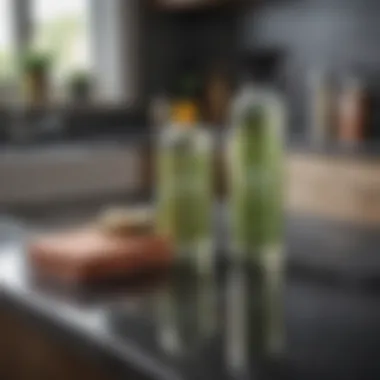
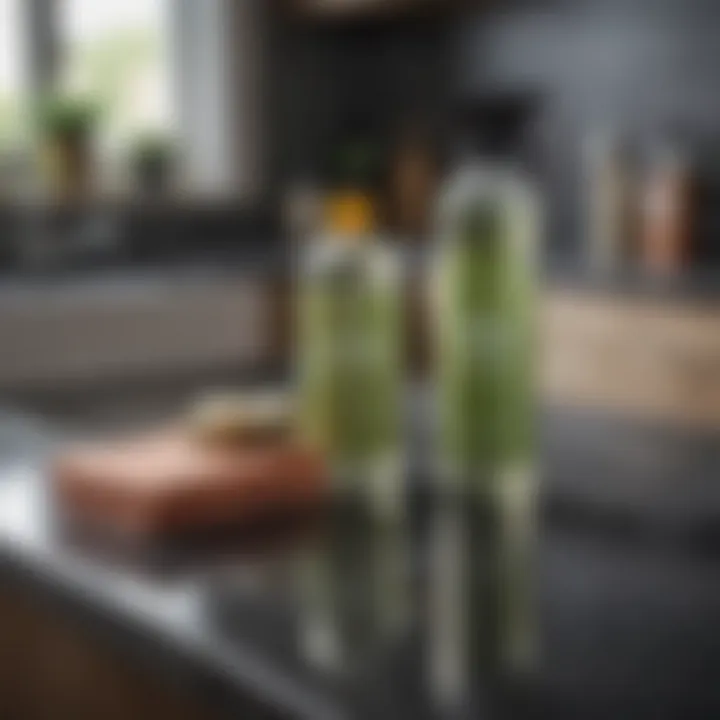
Using a Buffing Machine
A buffing machine can be a game changer when it comes to polishing granite countertops. These machines provide consistent pressure and speed, which can save time and effort. Here’s a simple guide on how to effectively use one:
- Choose the Right Buffer: Look for a buffer designed specifically for granite. The right tool makes a significant difference.
- Use Good Pads: Diamond pads are recommended. They come in various grits, so you can adjust based on the level of dullness.
- Follow the Grain: When using the buffer, always go with the natural grain of the granite, which will help minimize the appearance of swirl marks.
- Regular Maintenance: After buffing, consider sealing the surface again to maximize longevity. Sealing protects against stains and helps to maintain that polished look longer.
In summary, polishing granite countertops is not just a matter of aesthetics; it's key to ensuring their longevity. With the right products and proper technique, you can easily revive the beauty of your granite surfaces, enhancing both their function and design in your home.
Sealing Granite Countertops
Sealing is an essential process for maintaining granite countertops, a popular choice in many homes. It acts as a shield, helping to prevent stains and damage. Without a good seal, granite can absorb spills, leading to unsightly stains and potential integrity issues. This article dives into the importance of sealing, how to apply sealant, and the frequency of resealing, providing readers with a clear understanding of how to keep their granite surfaces looking fresh and vibrant.
Importance of Sealing
Sealing granite is more than just a cosmetic procedure; it plays a vital role in preserving the stone’s core properties. Granite is naturally porous, which means it can trap liquids and bacteria if not properly sealed. Sealing helps to:
- Resist Stains: Regular exposure to liquids such as oils, coffee, or red wine can lead to stubborn stains. A quality sealant forms a protective barrier, making it easier to wipe away spills before they seep into the stone.
- Enhance Lifespan: Over time, the integrity of granite can degrade if moisture penetrates. By sealing the surface, homeowners can extend its lifespan, protecting their investment.
- Maintain Visual Appeal: An additional benefit is the enhancement of the countertop’s natural color and shine, adding to the overall aesthetic of kitchens and bathrooms.
"A well-sealed countertop isn’t just about looks; it’s about longevity and ease of care."
How to Apply Sealant
Applying sealant to granite countertops isn’t a daunting task, but it requires attention to detail. Here’s a step-by-step guide to ensure effective application:
- Clean the Surface: Start by cleaning the countertop thoroughly. Use a granite-specific cleaner to remove any dirt or residue.
- Dry Completely: Ensure the surface is completely dry. Moisture can prevent the sealant from adhering properly.
- Choose the Right Sealant: Selecting the appropriate sealant is crucial. Look for products that are specifically designed for granite and are labeled as
'penetrating sealers.'
- Application: Use a clean cloth or applicator pad to apply the sealant evenly across the surface. It’s best to work in small sections to ensure thorough coverage.
- Let It Soak: Allow the sealant to soak into the stone for the time recommended by the manufacturer, typically around 10-15 minutes.
- Wipe Off Excess: After the recommended period, take a clean, dry cloth to wipe off any excess sealant.
- Cure Time: Let the sealant cure as per the instructions; this could take a few hours to fully set.
Frequency of Resealing
Most granite countertops benefit from resealing every one to three years, but the frequency can depend on several factors:
- Usage: High-traffic areas may need more frequent resealing. If your kitchen sees its fair share of spills and heavy use, keep an eye on the surface.
- Water Test: An easy way to determine if your granite needs resealing is to perform a water test. Sprinkle a few drops of water on the counter; if the water beads up, the seal is still effective. If it soaks in, it’s high time to reseal.
- Type of Sealant: Some sealants are designed to last longer than others. Always check the manufacturer’s recommendations, which can provide guidance on how long the seal should remain effective.
Incorporating these sealing techniques into your countertop care routine not only protects the functionality of your granite surfaces but also plays a significant role in maintaining their beauty. By being diligent about sealing, homeowners can enjoy the elegance of granite countertops for years to come.
Preventative Maintenance
Keeping your granite countertops looking fresh and vibrant doesn’t just happen on its own. Implementing a solid preventative maintenance routine is essential for preserving their beauty and longevity. This section focuses on strategies, habits, and general awareness that can help homeowners avoid the dulling and damage that can happen over time. Proper maintenance not only saves time and money but also can keep your space looking sharp and polished.
Daily Care Practices
The best way to avoid problems is to have a plan in place. Daily care practices are the backbone of granite preservation. Here are some straightforward steps:
- Wipe Down Spills Immediately: Granite may be durable, but it’s not impervious. Whenever a liquid is spilled, such as coffee or juice, address it right away. Use a soft cloth or paper towel to absorb the spill, as this limits staining possibilities and keeps the surface clear of grime.
- Use Mild Detergents: Regular cleaning should involve mild soap mixed with water. Abrasive cleaners can scratch the surface, while harsh chemicals can damage the sealant. Just a gentle wipe with a nonabrasive cloth helps maintain the shine.
- Avoid Excessive Heat: Placing hot pots directly on granite may not harm it significantly, but it could weaken the sealant over time. Always use trivets for hot cookware.
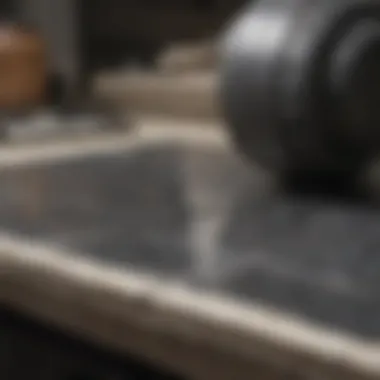
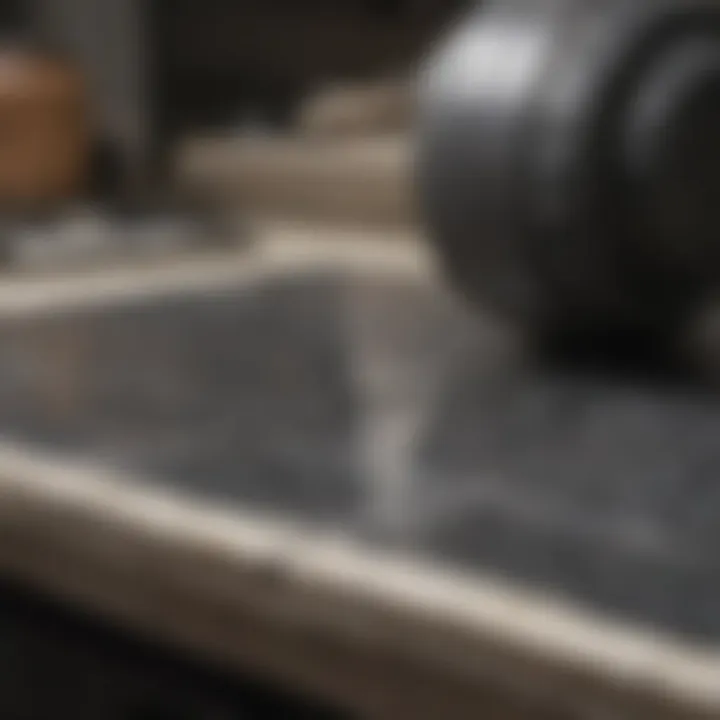
Incorporating these daily routines can vastly improve the overall appearance of your granite surfaces and extend the interval between deep cleans and polishes.
Avoiding Harmful Substances
Just as you take care of your own health, the same goes for your countertops. Being aware of harmful substances and their impacts is an important part of granite maintenance. Here are some things to watch out for:
- Avoid Acidic Cleaners: Products containing vinegar, lemon juice, or bleach may seem like strong cleaners, but they can eat away at the granite’s protective layer. Instead, rely on gentle soap and water.
- Skip the Scrubbing Pads: Scour pads can scratch the surface of your countertops, leading to dull patches. Stick with soft sponges or microfiber cloths to keep the surface intact.
- Be Mindful of Food and Drinks: Certain substances, like red wine or dark sauces, can leave stains if left unattended. Always have a cleaning cloth handy after cooking or hosting.
"An ounce of prevention is worth a pound of cure."
By following these insights and practices, homeowners not only of today but of future generations can ensure the granite's sheen remains intact. Your countertops will be a source of pride rather than a point of concern. Identifying and avoiding harmful substances minimizes the need for restorative measures later on, allowing you to enjoy the aesthetic appeal of your granite surfaces without the extra hassle.
Professional Help
When it comes to maintaining the pristine look of granite countertops, not every situation is a DIY fix. Professional help can be invaluable in certain circumstances. Think of it as calling in the cavalry when your countertop is waving the white flag. Choosing to consult a professional should feel like a wise defensive move rather than a last resort. Here are some specific elements and benefits to consider in this respect.
Expertise and Equipment
Professionals bring years of experience and specialized tools that aren’t usually found in the average household. They possess knowledge about various types of granite as well as the techniques that can rejuvenate dull surfaces effectively. Furthermore, they often have access to professional-grade products which align better with the specific needs of your countertops.
Time and Convenience
Let’s face it, the hustle and bustle of daily life doesn’t always allow for lengthy repair and restoration projects. By hiring a professional, you can spend your time doing things you actually enjoy rather than scrubbing, polishing, or sealing. Plus, they’ll likely complete the job faster than you would on your own—so you can have your beautiful countertops back in no time.
"You can attempt to restore your countertops yourself, but sometimes it’s like trying to fight fire with a squirt gun."
Potential for Long-Lasting Results
Getting professional help often equates to better quality work and longer-lasting results. If you don’t have the right skills or tools, you risk making things worse. A professional not only knows how to handle the job but can also provide preventative measures for future deterioration.
When to Consult a Professional
So you’re staring down at your granite countertops, and they look less like the glossy finish you envisioned and more like a faded memory. Knowing when to get a professional involved is half the battle. Here are some key signs indicating that it’s time to call for backup:
- Severe Stains
If your countertop has stubborn stains that just won’t budge no matter what you try, it might be time to bring in a specialist. Many professionals are equipped with the know-how to tackle even the toughest stains without damaging your granite. - Deep Scratches or Chips
Surface-level scratches might be manageable for a DIY buffing attempt, but deep scratches or chips require expert attention. Sometimes, repairs may necessitate a blend of skill and the right products to ensure a seamless fix. - Discoloration or Etching
If you've noticed uneven discoloration or etching on the surface, it's better to consult a pro. They can assess what’s happened, whether there's underlying damage, and what steps to take next.
Choosing the Right Service Provider
Finding the right service provider can feel like finding a needle in a haystack, especially when you want someone who understands the delicate nature of granite. Here are several factors to consider that can guide you on this journey:
- Experience
Check how long the company has been in the granite restoration business. A seasoned professional will have encountered a wide range of issues and can offer tailored solutions. If they've worked on similar countertop materials and types to yours, that’s a bonus. - Customer Reviews
Look for testimonials or reviews online. Websites or social media platforms like Facebook or Reddit can provide insights about previous clients' experiences. A reputable service should have a majority of positive feedback. - Written Estimates
Once you have a few candidates, ask for written estimates. This helps ensure transparency in pricing and services offered. Be cautious of any provider who is unwilling to give a detailed breakdown. - Guarantee or Warranty
Ask if they offer any guarantees or warranties on their work. A commitment to satisfaction can offer you peace of mind—in case anything goes awry, you’ll know you have recourse without extra expense.
Closure
Restoring the shine of granite countertops is not just a cosmetic endeavor; it is integral to maintaining their durability and longevity. As we’ve saw throughout the article, several techniques and practices can help bring back the original luster of these surfaces. It’s crucial to understand that granite, despite its sturdy nature, requires proper care. Ignoring dullness can lead to more severe issues over time, such as etching, staining, or even permanent damage.
Adopting a routine maintenance plan is beneficial not only for the immediate visual appeal but also for the overall health of your stone surfaces. The practical steps discussed will empower homeowners with the ability to tackle dullness proactively.
By investing time into understanding the characteristics of granite and the common pitfalls, you can save both time and money that might otherwise go to professional restorations. Even simple daily practices create a substantial impact over time.
"A little prevention goes a long way; treat your granite well, and it will return the favor."
Recap of Key Points
- Understanding Granite: It’s vital to grasp the composition and common issues that lead to dullness.
- Assessment: Regular evaluation helps in early identification of stains and damage.
- Cleaning Techniques: Knowledge of the right cleaners and cleaning methods can significantly extend the beauty of granite.
- Polishing: Knowing different polishing products and how to effectively use them makes a difference in restoring shine.
- Sealing: Maintaining granite with a suitable sealant ensures long-lasting protection against stains and scratches.
- Professional Help: Recognizing when to seek expert assistance can safeguard against potential mishaps.
- Long-term Strategies: Regular care and avoiding harmful substances play crucial roles in maintaining granite’s appearance.
Long-term Care and Considerations
- Regular Maintenance: Create a consistent cleaning schedule using gentle, pH-balanced cleaners specifically designed for stone.
- Sealing Frequency: Depending on the countertop's usage, resealing should generally be done every one to two years. Pay attention to any visible wear or water absorption tests.
- Choosing Cleaners Wisely: Avoid acidic or abrasive products that can harm the finish. Stick with mild soaps or granite-specific cleaners.
- Temperature Sensitivity: Keep hot pans off of granite surfaces to prevent thermal shock and potential cracks.
- Stain Management: Act quickly to wipe up spills, especially oily or acidic substances, which can weaken the surface over time.
- Surface Protection: Consider the use of coasters and cutting boards to minimize physical and chemical damage.
By following these guidelines, granite countertops can continue to serve as stunning centerpieces in your home, maintaining their beauty and strength for years to come.















